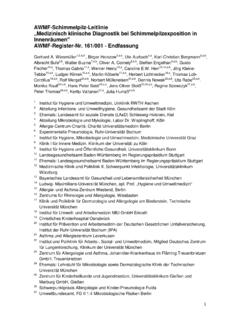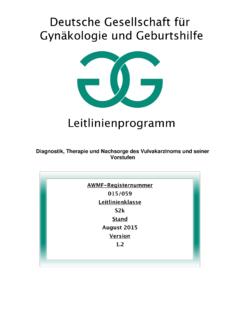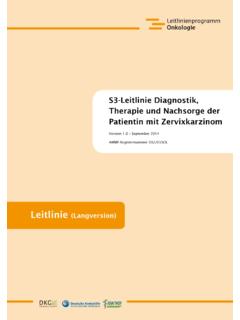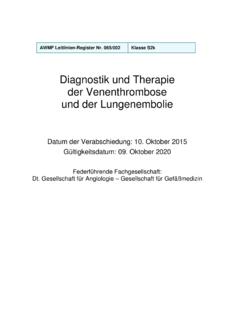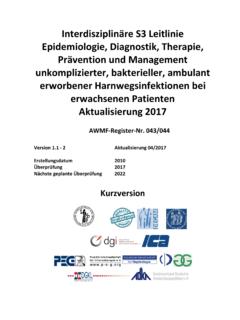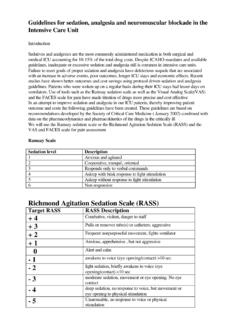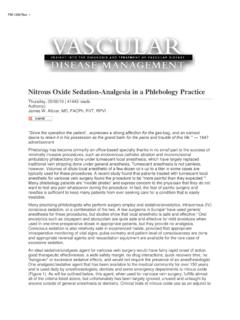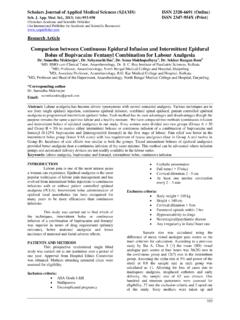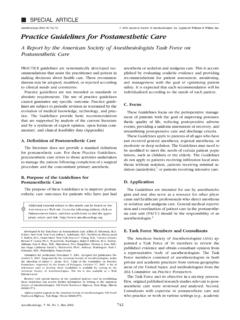Transcription of Evidenceandconsensusbasedguidelineforthe ...
1 OPEN ACCESS This is the original (English) version. Intensive Care Medicine The translated (German) version starts at p. 22. Guideline Evidence and consensus based guideline for the management of delirium, analgesia , and sedation in intensive care medicine. Revision 2015 (DAS-Guideline 2015) short version Abstract In 2010, under the guidance of the DGAI (German Society of Anaesthesi- DAS-Taskforce 2015: ology and Intensive Care Medicine) and DIVI (German Interdisciplinary Ralf Baron1. Association for Intensive Care and Emergency Medicine), twelve German medical societies published the Evidence- and Consensus-based Andreas Binder1. Guidelines on the Management of analgesia , Sedation and Delirium in Rolf Biniek1. Intensive Care . Since then, several new studies and publications have Stephan Braune2. considerably increased the body of evidence, including the new recom- mendations from the American College of Critical Care Medicine (ACCM) Hartmut Buerkle3.
2 In conjunction with Society of Critical Care Medicine (SCCM) and Peter Dall4. American Society of Health-System Pharmacists (ASHP) from 2013. For Sueha Demirakca5. this update, a major restructuring and extension of the guidelines were needed in order to cover new aspects of treatment, such as sleep and Rahel Eckardt6. anxiety management. The literature was systematically searched and Verena Eggers3. evaluated using the criteria of the Oxford Center of Evidence Based Ingolf Eichler7. Medicine. The body of evidence used to formulate these recommenda- tions was reviewed and approved by representatives of 17 national Ingo Fietze8. societies. Three grades of recommendation were used as follows: Grade Stephan Freys9. A (strong recommendation), Grade B (recommendation) and Grade Andreas Fr nd10. 0 (open recommendation). The result is a comprehensive, interdiscip- linary, evidence and consensus-based set of level 3 guidelines. This Lars Garten5. publication was designed for all ICU professionals, and takes into ac- Bernhard Gohrbandt7.
3 Count all critically ill patient populations. It represents a guide to symp- Irene Harth5. tom-oriented prevention, diagnosis, and treatment of delirium, anxiety, stress, and protocol-based analgesia , sedation, and sleep-management Wolfgang Hartl9. in intensive care medicine. Hans-J rgen Heppner6. Keywords: guideline, evidence, analgesia , sedation, delirium, anxiety, Johannes Horter3. stress, sleep, monitoring, treatment, intensive care, critical care, Ralf Huth5. Germany Uwe Janssens2. Christine Jungk11. Kristin Maria Kaeuper12. Paul Kessler3. Stefan Kleinschmidt3. Matthias Kochanek13. Matthias Kumpf5. Andreas Meiser3. Anika Mueller3. Maritta Orth8. Christian Putensen3. Bernd Roth5. Michael Schaefer14. Rainhild Schaefers12. GMS German Medical Science 2015, Vol. 13, ISSN 1612-3174 1/42. DAS-Taskforce 2015 et al.: Evidence and consensus based guideline for the management .. Peter Schellongowski13. Monika Schindler5. Reinhard Schmitt15. Jens Scholz3.
4 Stefan Schroeder16. Gerhard Schwarzmann15. Claudia Spies3. Robert Stingele1. Peter Tonner3. Uwe Trieschmann3. Michael Tryba3. Frank Wappler3. Christian Waydhas17. Bjoern Weiss3. Guido Weisshaar5. 1 German Society of Neurology (DGN). 2 German Society of Internal Medicine Intensive Care (DGIIN). 3 German Society of Anaesthesiology and Intensive Care Medicine (DGAI). 4 German Society of Gynecology & Obstetrics (DGGG). 5 German Society of Neonatology and Pediatric Intensive Care (GNPI). 6 German Society of Geriatrics (DGG). 7 German Society for Thoracic and Cardiovascular Surgery (DGTHG). 8 German Sleep Society (DGSM). 9 German Society of Surgery (DGCH). 10 German Association for Physiotherapy (ZVK). 11 German Society of Neurosurgery (DGNC). 12 German Society of Midwifery Science (DGHWi). 13 German Society of Haematology and Oncology (DGHO). GMS German Medical Science 2015, Vol. 13, ISSN 1612-3174 2/42. DAS-Taskforce 2015 et al.: Evidence and consensus based guideline for the management.
5 14 German Pain Society (DGSS). 15 German Society for Specialised Nursing and Allied Health Professions (DGF). 16 German Association for Psychiatry, Psychotherapy and Psychosomatics (DGPPN). 17 German Interdisciplinary Association for Intensive Care and Emergency Medicine (DIVI). Introduction and evidence-based targets for treatment, the assess- ment of the clinical situation with validated instruments, In 2010, twelve German medical societies published the and the goal-directed pharmacological therapy. These Evidence- and Consensus-based Guidelines on the measures are to be accompanied by non-pharmacological Management of analgesia , Sedation and Delirium. Since interventions aimed at prevention and treatment. this publication, the body of evidence in the field has in- The critically ill patient should be awake and alert, creased considerably. Several new studies and publica- without pain, anxiety, or delirium. Ultimately, this allows tions, including the new recommendations from the the patient to actively participate in their treatment and American College of Critical Care Medicine (ACCM) in recovery.
6 Conjunction with Society of Critical Care Medicine (SCCM) The term sedation was left in the title intentionally: the and American Society of Health-System Pharmacists indication and conduction of sedation require special at- (ASHP) in 2013, make a substantial actualization of the tention in order not to harm the patient through oversed- German guidelines necessary. This update not only ac- ation, as this has been proven to negatively affect patient counts for new evidence, but also contains a major re- outcome. In the interest of the patients, the use of seda- structuring and extension of the guidelines to cover new tives and analgesics must therefore be very carefully aspects of treatment, such as sleep and anxiety manage- considered. The patient must be allowed to be as alert ment. and oriented as possible, so that they may partake in the This new version aims to provide practical guidance for therapy and convalescence process, as evidence shows the symptom-based prevention, diagnostics and therapy is feasible, practical, and safe.
7 Of delirium, anxiety, and agitation, as well as for the pro- tocol-based analgesia , sedation, and sleep management during critical illness. Under the guidance of the German Methods Society of Anaesthesiology and Intensive Care Medicine (DGAI) and German Interdisciplinary Association for In- This guideline has the highest development credentials, tensive Care and Emergency Medicine (DIVI), this is one S3, indicating that it is both evidence- and consensus of the most comprehensive guidelines worldwide, being based. The guideline task-force consisted of 49 voting developed and approved by 17 national societies. members nominated by 17 participating national socie- These guidelines were developed for all professions ties. These members formed work groups that identified working in the intensive care unit (ICU), and its recom- main clinical issues and framed key-questions to be ad- mendations encompass critically ill patients of all age dressed.
8 Should previous versions of the guideline not groups and severity of illness, regardless of comorbidities. /no longer provide satisfactory resolutions to the selected Delirium and coma are the most common manifestations topics, search strategies were developed to address the of acute brain dysfunction during critical illness. Pain, subject. The resulting recommendations were then col- stress, and a disruption of the sleep-wake-cycle are typical lected in an early version and further discussed within symptoms observed during ICU treatment, all of which the groups. The members interacted with each other via can lead to delirium and impair outcome. An early man- consensus-conferences, email, fax, or mail. Communica- agement of these symptoms improves recovery and long- tion was managed by a coordinating group consisting of term outcome, while reducing post-intensive-care-unit- 4 members, as well as the chairing societies. A systematic syndrome (PICS) and mortality.
9 The basic principle follows literature search was performed by a special team under an early goal directed therapy (EGDT) with immediate the supervision of an epidemiologist. Finally, the evalu- GMS German Medical Science 2015, Vol. 13, ISSN 1612-3174 3/42. DAS-Taskforce 2015 et al.: Evidence and consensus based guideline for the management .. ation process was done by the individual working groups, Management of delirium, which also set the level-of-evidence (LoE). All searches were performed between April and May of 2014. When analgesia , and sedation in adult necessary, new evidence was integrated manually. The intensive care LoE was determined, as in the previous version of the guideline, using the Oxford System [1]. The overview Risk and prevention of ICU related tables allow to identification the evidence for each indi- vidual manuscript. Literature was accessible for all task- delirium force members. The specific search strategies, searched Pain, stress, anxiety, and a disrupted sleep-wake cycle terms, inclusion and exclusion criteria, as well as exact are common symptoms that occur in critically ill patients time frames, are all detailed in the methodological report.
10 That increase the risk for ICU related delirium [3]. Delirium Sources were electronic databases (Medline ), guideline is one of the most common manifestations of cerebral networks, and (manually) abstracts and congress-publi- dysfunction in critically ill patients, which affects not only cations. In order to identify grey literature , all task-force short-term recovery (in terms of prolonged ventilation and members were asked to search for publications outside length of stay, as well as increased mortality) [4], [5], [6], Medline and Embase and include relevant entries to the but also leads to cognitive long-term impairment, literature-data-base. Systematic guideline searches were posttraumatic stress disorders (PTSD), and reduced conducted within the AWMF-registry ( quality of life [7]. These entities are part of the Post In- ) and the Guidelines International Net- tensive Care Unit Syndrome (PICS) that has been recently work (G-I-N) ( ).
